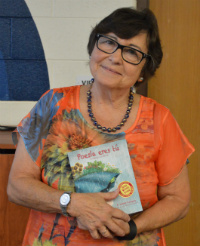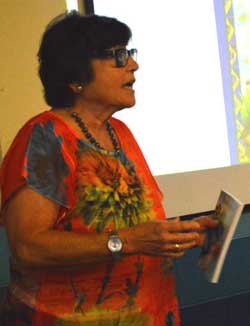Children’s author F. Isabel Campoy’s writing honors the Latino community, providing a fresh look at history and sharing the message, “It doesn’t matter where you came from. It matters where you are going.”
“I have spent my entire life writing about the culture, the biographies, the art, the history and the language of the Latino people,” said Campoy, whose most recent book, “Maybe Something Beautiful,” won first place in the International Latino Awards ceremony.
“My whole life has been devoted to showing children the richness of their past and to make them feel proud of the architects, the astronomers, the mathematicians, the writers, painters, the wealth of intellectual richness that is in the Latino community.”
Marking Hispanic Heritage Month, Campoy recently spoke to students at Burton, Buchanan and Cesar Chavez elementary schools, Westwood Middle School and during a community night for parents. About 70 families received free copies of “Maybe Something Beautiful.”
Grand Rapids Public Schools English Learner coordinator Kay Smith said Campoy’s visit was a great way to bring in a Latino role model to students. “She’s such a presence and knows so much about the Latino experience.”
Sixth-grader Ramon Hernandez, whose grandfather is from El Salvador, said he was inspired by Campoy’s words and he learned much about Latino history and contributions from Campoy’s presentation. “It is amazing,” he said.

Language, History, Writing
Campoy’s work is prolific and broad. She’s written 164 books, curriculum in Spanish and an EL program called “Moving Into English.” She has penned stories, poetry, art, biographies and folklore. She is the translator for children’s book author Mo Willems, and translated “For the Love of Soccer” by Pelé.
“I published my first story when I was 11,” she said. “The title of the book was “El Macho de Nieve,” “The Snowman.” I lived in a desert. I had never seen snow. My imagination was there.”
Campoy first came to the U.S. as an exchange student in 1963 from Spain, which was under rule of an oppressive dictator. She had received the American Field Service Scholarship to live in the U.S. and study at Trenton High School, in Michigan. She returned permanently to the U.S. in 1981 and worked as the senior acquisitions editor for foreign languages in the College Division of Houghton Mifflin Publishing Co. from 1981 to 1993.
She’s traveled far and wide, and emphasizes the value of language. She speaks Spanish, Catalonian, English and French. She can translate Italian and Portuguese and has studied Arab and Russian.
“My entire purpose is making sure, first, that they learn English, (and) second, that they don’t forget Spanish, because two is always better than one,” Campoy said. “Two eyes, ears, legs, arms and languages. You can do twice as much good if you have two languages.”

Campoy said she also wants children to learn of the many contributions of Latino people, which are often overlooked. Campoy asked students if they know where the pyramids are located. They answered, “Egypt.”
“Are you aware that 100 miles from the border of the U.S. you have the most amazing, fantastic, illuminating pyramids that were created in this continent by your ancestors?”
Also, she told them of Carlos Finley, a Cuban epidemiologist who researched yellow fever and was the first to pinpoint mosquitoes as the cause, though Walter Reed is much more well known for confirming the theory.
“History belongs to those who write it and most of it has been written by the winners. There are many things that are not known… It is necessary to have the perspective that comes from a different point of view,” Campoy said.
She said words and relationships build communities. “I hope you take two things from this presentation: in order to create a forward, positive community, we need to know each other. Try to reach out and know whatever communities you have around you. That will make you grow, will make you better, will make you more dignified.
Then try to learn the words to express their souls. With words you will make a lot of progress.”
CONNECT









